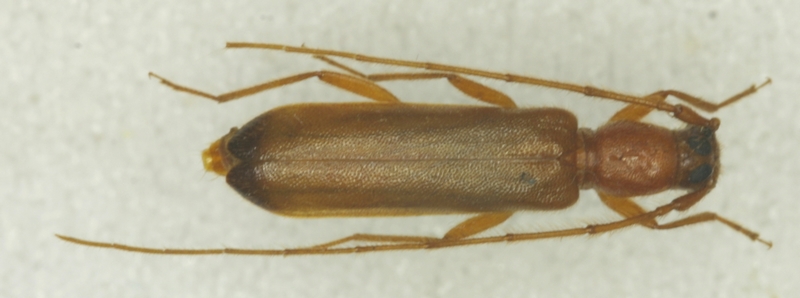| T O P I C R E V I E W |
| cerambyphil |
Posted - 23/12/2015 : 23:38:15

140.32 KB
From Sabah, Trus Madi, 12 mm |
| 4 L A T E S T R E P L I E S (Newest First) |
| Xavier |
Posted - 08/05/2022 : 14:28:55
Holotype female of Tetraommatus fuscoapicalis Jacquot, 2020. |
| horshehden |
Posted - 27/12/2015 : 22:01:12
Sorry but T. nigriceps from the peninsula has a small spine as well; moreover, elytra are completely dark brown.
Light species with small lateral spine on pronotum is T. testaceus (but head and 1-4 antennal segments little darker). |
| cerambyphil |
Posted - 27/12/2015 : 21:30:26
Thank you Dan for all those informations. An other day I will put a picture of an other Tetraommatus with a little spine on each side of the pronotum, but it is not T. callidioides, maybe the new species your are describing ? It is all orange except the six tibia and the antennomeres 2 to 11. |
| dryobius |
Posted - 27/12/2015 : 18:41:37
This is a female Tetraommatus species. It might be one of the three new species of Tetraommatus which Vives and I are describing from one male and one female (manuscript has been submitted by Vives). It might also be T. nigriceps Pascoe, 1869 (type locality: Singapore, but recorded from Kalimantan by Makihara).
Your specimen does not have annulate antennae, however the holotype male and paratype female do. The holotype has dark coloring on the apices of the tibiae, and the female paratype does not. The apex of the elytra have similar dark areas in all three specimens, but the amount of darkness is slightly different.
There are not a lot of specimens available for study so it's impossible to understand the variability of the color. This is another genus that must be revised in the future.
One of the new Tetraommatus has a clytine like elytra pattern and another has a short spine on the side of the pronotum (like T. callidioides but different colored elytra). Obviously, yours is not either of those. |


